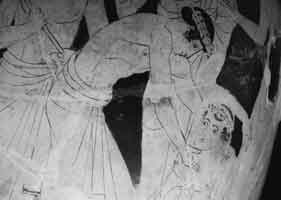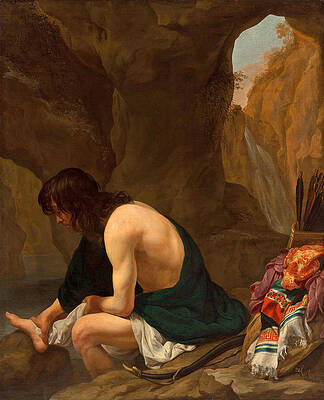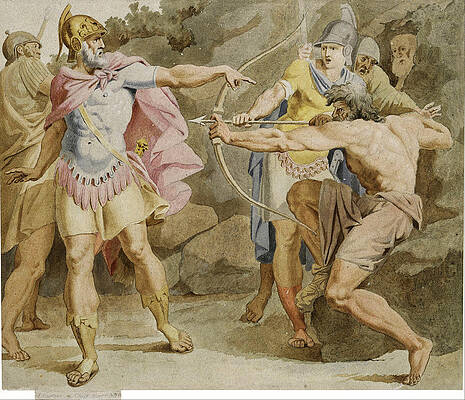.
Hard by is a bronze statue of Diitrephes shot through by arrows....I was greatly surprised to see the statue of Diitrephes pierced with arrows, because the only Greeks whose custom it is to use that weapon are the Cretans. For the Opuntian Locrians, whom Homer represents as coming to Troy with bows and slings, we know were armed as heavy infantry by the time of the Persian wars. Neither indeed did the Malians continue the practice of the bow; in fact, I believe that they did not know it before the time of Philoctetes, and gave it up soon after. Pausanias
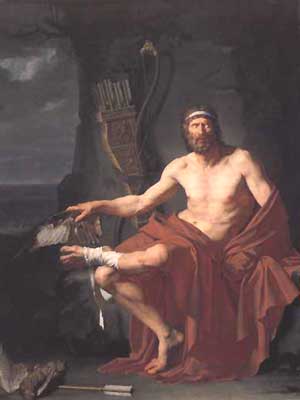
Philoctetes on Lemnos, 1788, Jean-Germain Drouais (1763 - 1788), (1.76 m x 2.25 m) Chartres, Musée des Beaux-Arts
In Greek mythology, Philoctetes (also Philoktêtês or Philocthetes) was the son of King Poeas of Meliboea in Thessaly.
He was one of the Argonauts, as well as the personal friend and arms-bearer of Heracles. He was present at the death of Heracles and, because he lit Heracles' funeral pyre (or Iolaus did) when no one else would, he received Heracles' bow and arrows. The arrows were dipped in the gall of the Hydra. He took a solemn vow to never reveal the location of Heracles's ashes.
He traveled to Sparta and became one of the suitors of Helen of Troy. She married Menelaus. All of the suitors took vows to protect Helen, and so, when she ran off with Paris, Menelaus called upon Philoctetes to sail to Troy.
There are two separate tales about what happened to strand Philoctetes on his journey to Troy. He received a wound on his foot that festered and had a terrible smell. Odysseus removed Philoctetes from the Greek camp and stranded him on Lemnos or Chryse.
One version holds that Philoctetes was bitten by a snake that Hera sent to molest him as punishment for his service to Heracles (bastard son of Zeus). Another tradition says that the Greeks forced Philoctetes to show them where Heracles's ashes were deposited. Philoctetes would not break his oath by speech, so he went to the spot and placed his foot upon the site. Immediately, he was injured in the foot that touched the soil over the ashes.
Philoctetes, whose story has been treated elsewhere, was a master- archer, perhaps inventor of some new type of bow, such as the bow with bent -back curvature at the tips for a secondary spring effect, which is a kind of bow that Homer mentions. But he is rejected by the army storming Troy, left on a desert island on the weak excuse that he had a badly infected foot which represented a curse, and only when the military realize that they need his weapon, is there any attempt to make a reconciliation with him William Harris, Man the Inventor of Tools
Regardless of the cause of the wound, Philoctetes was not able to join the rest of the Greeks and was angry at the treatment he received from Odysseus, who had advised the Atreidae to strand him. Medon took control of Philoctetes' men. He was there on Lemnos, alone, for ten years.
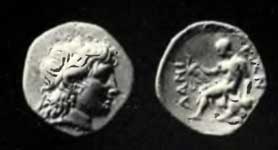
Drachme , Lamia Head, Philoctetes on Lemnos, Text Lamiaion (Thessaly), 302/386 BC
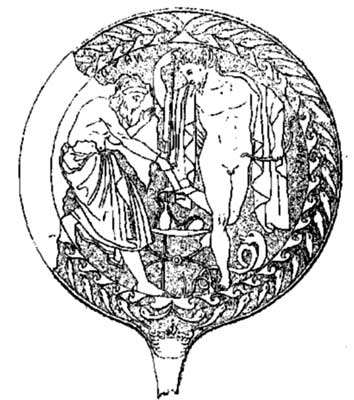
Machaon and Philoctetes, Etruscan Mirror
Later though Helenus, son of King Priam of Troy, was tortured until he revealed that one of the conditions of the Greeks winning the Trojan War was that they had the bow and arrows of Heracles. Odysseus and Neoptolemus retrieved Philoctetes from Lemnos. Philoctetes' wound was healed by Machaon or Podalirius. Philoctetes then killed many Trojan worthies, including Paris, son of Priam and husband of Helen.
After the war, he went to Italy and founded the town of Petilia in Calabria and establish the Brutti.
His story is told by Sophocles, as well as Virgil, Pindar, Seneca, Quintilian, and Ovid.
The legend of Philoctetes was, in part, the inspiration for Robert Silverberg's science fiction novel The Man in the Maze.
Philoctetes on Lemnos, Gerard van der Kuijl
Philoctetes Print by Ivan Akimov" src="https://render.fineartamerica.com/images/images-profile-flow/400/images/artworkimages/mediumlarge/1/hercules-burning-himself-on-the-pyre-in-the-presence-of-his-friend-philoctetes-ivan-akimov.jpg" alt="Hercules Burning Himself On The Pyre In The Presence Of His Friend Philoctetes Print by Ivan Akimov" />
Hercules Burning Himself on the Pyre in the Presence of His Friend Philoctetes, Ivan Akimov
Philoctetes Print by Nicolai Abraham Abildgaard" src="https://render.fineartamerica.com/images/images-profile-flow/400/images/artworkimages/mediumlarge/1/the-wounded-philoctetes-nicolai-abraham-abildgaard.jpg" alt="The Wounded Philoctetes Print by Nicolai Abraham Abildgaard" />
The Wounded Philoctetes, Nicolai Abraham Abildgaard
Philoctetes aiming the bow of Hercules at Odysseus, Asmus Jacob Carstens
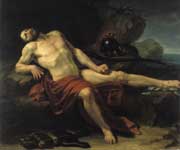
Philoctetes, Vincenzo Baldacci
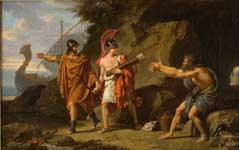
Ulysses and Neoptolemus Taking Hercules’ Arrows from Philoctetes, François-Xavier Fabre
Philoctetes, 1775, Nikolaj Abraham Abildgaard (11 September 1743 - 4 June 1809 )
Hercules and Philoctetes, Ivan Akimovich Akimov 1814
Sophocles Philoctetes
See also : Greek Mythology. Paintings, Drawings
| Ancient Greece
Science, Technology , Medicine , Warfare, , Biographies , Life , Cities/Places/Maps , Arts , Literature , Philosophy ,Olympics, Mythology , History , Images Medieval Greece / Byzantine Empire Science, Technology, Arts, , Warfare , Literature, Biographies, Icons, History Modern Greece Cities, Islands, Regions, Fauna/Flora ,Biographies , History , Warfare, Science/Technology, Literature, Music , Arts , Film/Actors , Sport , Fashion --- |
Retrieved from "http://en.wikipedia.org"
All text is available under the terms of the GNU Free Documentation License

